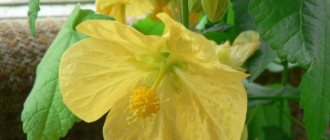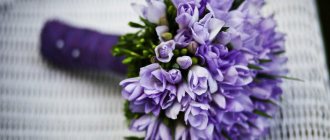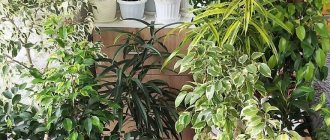What are home grown white flowers with a red center called?
A houseplant with white and red flowers is called clerodendrum. The complex name of this plant translates as “tree of fate.” There is a Javanese legend associated with it that clerodendrum brings happiness. A distinctive feature of these plants are their unusual flowers that take the shape of a butterfly.
Clerodendrum Thomson
Thomson's clerodendrum is a woody vine with fast-growing shoots. This plant is a rare guest in Russian apartments. The most common variety was Prospero. It is distinguished not only by its flowers, but also by its leaves, which look like thick branches. The aroma of blooming clerodendrum has jasmine notes - for this feature the vine was nicknamed “nodding jasmine” by the Japanese.
Description
Clerodendrum blooms in the summer season. The first flowers appear in June, and in September the plant begins to prepare for hibernation. But if we consider the Fragrant Clerodendrum, it is capable of blooming all year round with proper care. The aroma of the plant comes not only from the buds, but also from the leaves. The smell may vary depending on the variety.
The leaves of the vine reach a length of 20–30 centimeters. The shoots of the plant quickly become woody during the period of active growth.
Flower growers note the following features of clerodendrum:
- The shape of the bush is adjusted by pinching and pruning. The plant can be bush-like, ampelous or standard.
- The flower surprises with its unpretentiousness and endurance. During the dormant period, it does not freeze even at a temperature of twelve degrees.
- As the bush matures, it needs to be replanted less frequently. A young plant changes pots once a year. Mature - once every 3-4 years.
Care
During the growing season, clerodendrum needs periodic watering. It is necessary to spray the plant with a spray bottle in the evening. The bushes tolerate soft, settled water well. The frequency of watering is determined by temperature conditions. On hot summer days, the vine needs frequent watering. At other times, hydration is reduced. To determine a flower’s need for moisture, just look at the soil.
Important. In order for the flower to be preserved over the winter, it must be protected from all heating devices. Despite hibernation, clerodendrum may suffer from excessive dry air. Overdrying the earthen clod will result in the death of the plant.
Flower growers begin to fertilize clerodendrum in the second half of April. To saturate the plant with microelements, two feedings per month are enough. Complex fertilizer for flowering indoor plants is used as fertilizing. During the hibernation months, the bush does not need fertilizers.
Clerodendrum requires periodic pruning to adjust growth. Two types of pruning are applied to the plant:
- Rejuvenating. During rejuvenation, weak and dried shoots are removed. Healthy stems are shortened by a third to stimulate growth. If you follow the pruning rules, the bushes will produce young, fast-growing shoots. Inflorescences will begin to actively form on these shoots.
- Formative. A dense crown is the key to the health and beauty of the plant. If a gardener wants to turn clerodendrum into a bush, in the spring he will need to greatly shorten the stems. To give a flower a stem shape, it must be removed from all shoots except one - the strongest. To form the crown, all upper stems are pinched.
Clerodendrum needs frequent soil renewal. It quickly absorbs all nutrients and depletes the substrate. Another reason for replanting is that the pot is cramped: if there is not enough space, the plant will wither. The transplant should coincide with the beginning of the growing season. If the grower plans to prune the bush, this task must be completed before replanting.
The bush is suitable for fertile soils with a slightly acidic reaction. You can buy the substrate at the store or prepare it yourself.
The following components will be needed for the soil mixture:
- coarse sand;
- peat;
- clay and leafy soil.
Important. Before planting clerodendrum, the substrate must be disinfected. For these purposes, gardeners use ovens, ovens or microwaves.
When transplanting, the exact sequence of actions must be followed:
- A drainage layer 3 centimeters high is poured onto the bottom of the pot.
- The flower is lowered into the pot using the transfer method. During transplantation, you need to try not to damage the earthen ball.
- The voids in the pot are filled with prepared substrate.
- After compacting the earth, the bush is watered.
If the plant requires support, it is installed during transplantation. If you stick a stick into the soil mixture later, there is a risk of damaging the root system.
Main varieties of amaryllis and photos
Modern amaryllis breeding is developing in three directions:
- Search for new varieties or improvement of known ones to increase flower size. These include the following terry varieties: DoubleRoma, Celica, DoubleDragon, etc. Non-double varieties include Ampulo, BlackPearl, Exotica, Moonlight, Matterhorn, WhiteBaby, etc.
- Search for original multi-color colors or add new ones to existing ones. The following interesting specimens were bred in this direction: Charisma, Gervesa, Temptatia, Prelude, Clown, Neon, Pizazz, etc.
- Changing the shape of a flower, creating narrow-petalled varieties, so-called “spiders”. This group includes Grandeur, Spotty, Evergreen, Lima, La Paz, etc. These varieties are inferior to large-flowered amaryllis, but are good in group compositions.
Flowers with large leaves
Flowers that differ in the size of their leaves include:
- Anthurium. The leaves of this plant reach a length of 30 centimeters. Flowers with a yellow erect inflorescence and a bright red petal that resembles a sail. Anthuriums are light-loving flowers that do not get along with drafts and coolness.
- Spurge. Euphorbia leaves are dark green in color. Their length ranges from 10 to 15 centimeters. The deep red petals are shaped like the pointed leaves. This plant blooms during the winter months.
- Vallota. Wallot leaves are pointed and sword-shaped. They can reach half a meter in length. They come in a dark green shade, which turns into dark red towards the base. With proper care, the plant blooms twice a year.
- Clerodendrum. The leaves of the plant grow up to 30–35 centimeters and have the shape of a vine. The plant itself has become famous due to the unusual color of its flowers, which combines red and white.
Origin and description
Amaryllis (Amaryllis) is a perennial plant of the Amaryllis family, consisting of one species - Amaryllis belladonna, or beautiful (Amaryllis belladonna), first mentioned in 1753 by Carl Linnaeus when describing the garden of the burgomaster of Amsterdam. Amaryllis was brought to Europe from South Africa and for several centuries it has enjoyed deserved popularity among flower growers.
Amaryllis is a bulbous plant. Its leaves are straight, oblong, 2-3 cm wide, up to 60 cm long, arranged in two rows. The diameter of the pear-shaped bulbs reaches 12 cm. Each bulb produces a long bare peduncle (sometimes two), on which there is an inflorescence of several funnel-shaped fragrant flowers from white to shades of red, pink, and purple. The flowers, 5–8 cm in diameter, have six petals with pointed tips.
Problems during cultivation
Leaves turn yellow when infested with thrips
Caring for amaryllis at home is easy. But when growing amaryllis, you should pay attention to the following points:
- If the flowers turn pale, then it is necessary to remove the pot from direct sunlight. In a damp and cold room, flowers, on the contrary, darken and sometimes turn black.
- Flowers droop and leaves turn pale with insufficient watering.
- Leaves turn yellow when attacked by thrips or other pests.
Sudden changes in the development and growth of the plant indicate damage by a fungus or insects.
The beauty of bulbous plants lies in their gorgeous flowers. But with insufficient care, the plant can become capricious and, as a result, the long-awaited flowering does not occur. Amaryllis does not bloom for several reasons:
- the bulb did not have a state of rest;
- with a lack of sunlight;
- the room is too cold;
- the soil is not fertile enough;
- the bulb is damaged by pests.
[adsp-pro-6]
Any of these reasons weakens the plant, and it does not have enough strength to release a peduncle. To ensure that the wait is not in vain, it is necessary to exclude all negative factors, and also remember that a plant with a young bulb blooms in the third year, and if amaryllis is grown from seed, in 7-8 years.
How to care for poinsettia after flowering
So, you have already realized that after shedding the red “leaves”, the poinsettia does not die at all, even if outwardly it looks completely lifeless, it simply begins a pronounced dormant period.
This means that the plant needs help:
- gradually reduce watering to a minimum;
- when the leaves fall off completely, trim the bush to a height of 10-15 cm;
- place the pot in a cool, dark place, water a little into the tray about once every two to three weeks;
- after about two months, in May, transplant the “Christmas star” by transferring it into a larger container;
- Place the poinsettia in the new pot in its usual bright location and begin to resume watering until new shoots appear.
You shouldn’t leave too many new shoots – 3-4 of the most beautiful, strong and healthy ones are enough. You can use the removed shoots for cuttings - poinsettia propagates quite easily in this way.
This is interesting
Despite its exquisite beauty, amaryllis is a poisonous plant. Its bulbs contain the alkaloid lycorine, which can cause poisoning. This property of the plant was known to the African natives, who lubricated arrowheads with amaryllis juice, making them deadly. In small doses, this substance was used as an anesthetic.
Watch also a short video clip on amaryllis flowers; in this video, an experienced gardener shares his experience in growing these flowers and at home.
Alternanthera
Another red plant known for its various types: rhineka, marble, lilac. One of the most beautiful aquarium red plants with long leaves.
Alternanthera prefers strong lighting and low temperatures - 18-20 degrees Celsius. In this case, water can be both soft and hard, acidic and alkaline. The soil must contain nutrients, definitely iron, and fertilizers are regularly added to the water.
Alternanthera has a long stem and grows quite quickly, so it is used for background decoration and needs regular guarding. The mini shape is suitable for a nano aquarium.
How to distinguish amaryllis from hippeastrum
The main difference is the structure of the stem. This picture shows a hippeastrum
Due to its external similarity, hippeastrum is often confused with amaryllis. But these two plants are united only by belonging to the same family - amaryllis.
Plants have different origins. The homeland of the beautiful Amaryllis (the only one of its kind) is South Africa, and the hippeastrum was brought from the tropics and subtropics of South America and has about a hundred species.
The main difference between plants from each other is the structure of the peduncle stem . In amaryllis it is homogeneous and dense, and therefore is capable of bearing a large number of fragrant flowers (6-12), and on the hollow arrow of the hippeastrum up to 6 flowers that have no smell are formed. Other differences include the following:
- Hippeastrum flowers are larger. Their size is 12-15 cm, and for amaryllis the maximum is 8 cm.
- The flowering period of amaryllis is leafless, while hippeastrum has a belt-shaped leaf that grows during flowering.
- Hippeastrum is grown exclusively as a houseplant, and amaryllis can be planted in open ground on the south side of the site.
Oxalis species
Triangular sorrel, also purple ( Oxalis triangularis )
This variety of indoor wood sorrel is one of those recognized by amateur gardeners. It looks like a tuberous, low bush. This beauty consists of spotted, trilobed, dark purple leaf blades, the central part of which is a lighter shade. They are presented with long petioles.
Purple oxalis is original in that its leaves resemble the fluttering wings of a butterfly-moth. This is where another name for the flower comes from - “Madame Butterfly”. Pleases the eye with small white, lilac and light pink delicate flowers.
Common sorrel (Oxalis acetosella)
The favorite location for common wood sorrel is a shady coniferous forest. Here the perennial sorrel grass reaches a height of five to twelve centimeters. And it is formed on a thin creeping rhizome. Thin flexible petioles bear green triangular-shaped leaves whose lobes resemble hearts. In general, the leaves exactly copy the leaf blades of clover.
In the spring-summer period, ten-centimeter peduncles bear white single flowers on rounded petals with purple or pink veins.
Four-leaved wood sorrel (Oxalis tetraphylla), also known as Deppe's wood sorrel (Oxalis deppei)
The native areas of the bulbous perennial flower are considered to be Mexico and Panama. This species is known as indoor and garden oxalis. Green sorrel has four-lobed leaves with a red-brown center. In summer, Deppe's oxalis delights with long-lasting blooms of funnel-shaped pink or violet-red flowers that form umbrella-shaped inflorescences. Among the English, four-leaf oxalis is known as “lucky clover.”
Oxalis tuberosa
The native habitat of this herbaceous annual is Central and South America. Here this green sorrel competes with potatoes. Large nodules rich in starch grow on the roots of the plant, which the local population widely uses in their diet. They are fried, boiled, stewed, and used to make starch.
Oxalis Iron cross
Oxalis Iron Cross is the most popular twenty-centimeter variety with a large rhizome. It is also called the iron cross. Iron sorrel flaunts green, round, four-lobed leaf blades, the central parts of which are painted with purple-brown spots. The leaves droop on long stalks creating a “skirt” effect. Tall flower stalks bear umbrella inflorescences of bell-shaped red-pink decorative flowers.
Carob sorrel (Oxalis corniculata)
Oxalis is a low-growing groundcover grass that spreads very quickly in gardens. This beautiful weed has original brown cherry leaves. It blooms with small single, or collected in groups of three, light pink flowers.
Variegated sorrel (Oxalis versicolor)
The maximum height of the South African beauty can reach fifteen centimeters. It is radically different from other oxalis with its unusual white and red striped flowers, visually reminiscent of candy candies from childhood. Oxalis photo you can see and admire this extraordinary beauty. These lush and dense bushes, due to their creeping rhizomes, are organized by bright green three-fingered leaves.
Oxalis stricta
Both perennial and annual wood sorrel grass reaches thirty centimeters in height. This variety of wood sorrel is distinguished by erect, slightly pubescent stems that branch generously from below. Oxalis is famous for its green, complex-shaped leaves. The three heart-shaped segments of the unique leaf blades tend to come together closer to night or in rainy weather. In the sun they straighten out again.
The decoration of the North American beauty in the warm season are five-petal flowers of a yellow-golden hue, funnel-shaped.
Oxalis has a pleasant sour taste, is similar to sorrel, and is rich in vitamin C. It can be added to salads and soups.
Traditional medicine recommends oxalis tea against scurvy. Alcohol tincture treats liver, kidneys, and exhaustion.
Cryptocoryne flamingo
A rather rare variety of Cryptocoryne Wendt with leaves of an unusual pink color. It grows very slowly and needs stability in everything: temperature, water parameters. Doesn't like moving - it's better not to move it often. However, the flamingo crypt can grow in a wide range of temperatures and other water parameters. In strong light, with the supply of nutrients, it becomes the most beautiful color.
Propagation by seeds
The amaryllis flower can reproduce by seed. In order for fruits to form during flowering, the flower must be pollinated. To do this you will need a small brush. With its help, cross-pollination is carried out, that is, pollen from one flower is transferred to another. Then you need to allow the plant to mature.
The process takes more than one month. When the seed pods are formed, you need to wait until they become yellow-brown in color. Each fruit has three compartments. They contain about fifty seeds. They must be collected and dried thoroughly. To do this, the rudiments are laid out on a clean cloth or tray and left for one month.
The prepared rudiments are placed in water at room temperature. There they will hatch, and after another three weeks they can be planted in the ground. The root system is still very fragile, so a separate container is prepared for each amaryllis.
Dried seeds can also be placed in the ground. A shallow container with holes for draining water is suitable for this. Sand and turf are suitable as a substrate. Seeds are scattered over the surface. The seeds do not have to be planted immediately; they can be stored in the refrigerator, but not more than one year.
The buds in the soil must be sprinkled with a small layer of soil. It is better to water every day so that dry soil does not damage them. Moisture can be retained using polyethylene covered on top. But seedlings must be ventilated every day. After a month, the first shoots should appear. Then fertilizing is added to the watering.
A plant that appeared by seed will only be able to bloom after seven years. While the bulbous version will produce an inflorescence already in the third year of life.
The flower is not for a child's room
The blooming amaryllis flower is extremely beautiful, but you should not place it in the children's area. All its areas have an increased concentration of toxic substances. The plant can cause a gag reflex. If the flower juice enters the animal’s body, swelling, pain in the mouth and stomach, and breathing problems will appear. Children and pets should not have access to the plant.
In rare cases, amaryllis blooms can cause allergic rhinitis and skin irritation. In this case, you should say goodbye to the flower.
If a flower does not cause allergies, you can enjoy it for many years. In order not to harm yourself with the poisonous juice, all manipulations with it should be carried out wearing protective gloves.
Diseases and pests of amaryllis plants
Frequent diseases of amaryllis: fusarium, anthractosis, stagonospora
Like any plant, amaryllis suffers from parasites and diseases. Insects settle on both above-ground and underground parts of the plant. The most common pests are:
- The amaryllis scale insect is a white, waxy insect that parasitizes under onion scales. Sooty fungi appear in the places where he defecates, which damage the bulb. A diseased plant loses leaves and slows growth. Insecticides are used to control scale insects.
- The onion mite lives in the soil and damages the bulbs by biting into them. This leads to rotting and the occurrence of fusarium, and the plant itself looks depressed: the leaves turn yellow, the inflorescences become smaller. A favorable environment for the development of onion mites is high air temperature and high humidity.
- Mealybugs are found on leaves and stems in the form of white fluffy spots. The pest can be destroyed by wet wiping.
- If brown spots appear on the leaves and insects appear on the flowers, it means that the amaryllis has been attacked by a false scale insect. You can fight it with soapy water or special insecticides.
Insect pests, in addition to mechanical damage to plant parts, are distributors and provocateurs of fungal diseases. Most often, amaryllis suffers from:
- fusarium (root rot).
- anthractosis (the appearance of dark spots and brown streaks on the leaves);
- stagonosporosis (redness of the bulbs).
Treatment for fungal diseases includes isolating the plant, removing affected leaves, treating the bulbs with fungicides (Bordeaux mixture, Fundazol), as well as updating the planting material.
How best to care for indoor crossander flowers at home.
How to grow streptocarpus flower from seeds? Be sure to check out this material.











